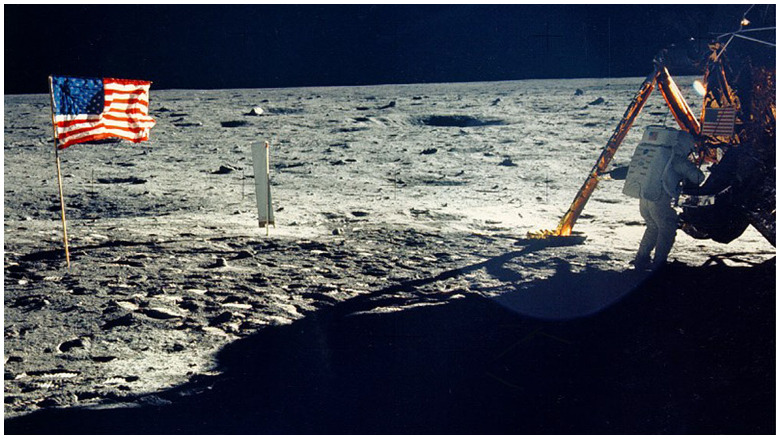
Getty Neil Armstrong and the American flag on the moon. The First Man movie left that moment out.
It’s been a major point of contention: In the climactic scene in the movie First Man, when astronaut Neil Armstrong steps on the moon’s surface, one thing does not appear: The American flag.
Why did First Man leave out the American flag? After all, it’s a part of history. The question has created controversy and Armstrong’s legendary flag planting made it into a President Donald Trump rally speech. The filmmakers, lead actor and Armstrong’s family have addressed the flag question and defended the movie’s decision to leave it out.
The American flag does make it into the First Man movie in other scenes (Huffington Post counted 18 such moments); it’s just not seen planted on the surface of the moon.
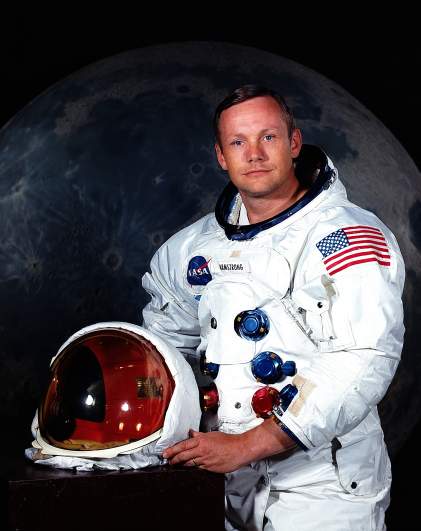
GettyAstronaut Neil A. Armstrong poses for a portrait July 1969.
Here’s how the 1969 story in The New York Times described the real flag planting moment:
“After 19 minutes of Armstrong’s testing, Colonel Aldrin joined him outside the craft.
The two men got busy setting up another television camera out from the lunar module, planting an American flag into the ground, scooping up soil and rock samples, deploying scientific experiments and hopping and loping about in a demonstration of their lunar agility. ”
Armstrong told President Nixon from the moon: “Thank you Mr. President. It’s a great honor and privilege for us to be here representing not only the United States but men of peace of all nations, men with interests and a curiosity and men with a vision for the future.”
July 20, 2019 is the 50th anniversary of the Apollo 11 Moon landing. Neil Armstrong and Buzz Aldrin set foot on the moon. According to Fox News, “just 10 more NASA astronauts would follow in their footsteps by walking on the lunar surface. The last human to set foot on the Moon was Apollo 17 astronaut Eugene Cernan on Dec. 14, 1972.”
Here’s what you need to know:
Some Have Criticized the Decision to Omit the Flag But Others Defended It
Astronaut Buzz Aldrin, who joined Neil Armstrong in the famous moon walk, tweeted out pictures of the flag on the moon as the movie controversy raged. Senator Marco Rubio, a Republican from Florida, tweeted, “This is total lunacy. And a disservice at a time when our people need reminders of what we can achieve when we work together. The American people paid for that mission,on rockets built by Americans,with American technology & carrying American astronauts. It wasn’t a UN mission.”
However, Ryan Gosling, the actor who plays Armstrong in the movie, said, referring to the flag controversy, that the moon walk “transcended countries and borders.” Gosling himself is Canadian.
“I think this was widely regarded in the end as a human achievement [and] that’s how we chose to view it,” Gosling said, according to UK Telegraph. “I also think Neil was extremely humble, as were many of these astronauts, and time and time again he deferred the focus from himself to the 400,000 people who made the mission possible.”
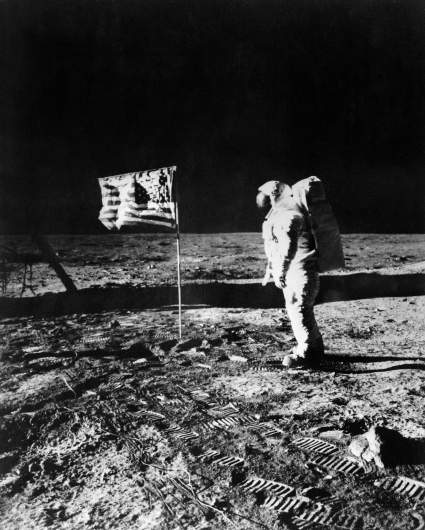
GettyUS astronaut Edwin Aldrin stands on the moon 16 July 1969 beside the deployed flag of the United States during the Apollo 11 mission.
He added, according to CNN: “So I don’t think that Neil viewed himself as an American hero. From my interviews with his family and people that knew him, it was quite the opposite. And we wanted the film to reflect Neil.”
Screenwriter Josh Singer explained to Esquire, “This whole movie is very patriotic. We feel the movie is really about an American family that really struggled through some extraordinary challenges and really managed to plow forward despite those challenges.”
He continued, Esquire reports: “In terms of the actual flag, it’s just we were so intensely interested in what you didn’t know, what you hadn’t seen, so interested in Neil’s personal—what happened to him and seeing these things in his eyes on the moon. It’s a celebration of American work ethic and American exceptionalism. It’s just a re-telling of what American exceptionalism is, which is not that we’re born exceptional, but that these people put in the work and the sacrifice. I think it’s certainly the most patriotic movie of the year, if not the most patriotic movie of many years.”
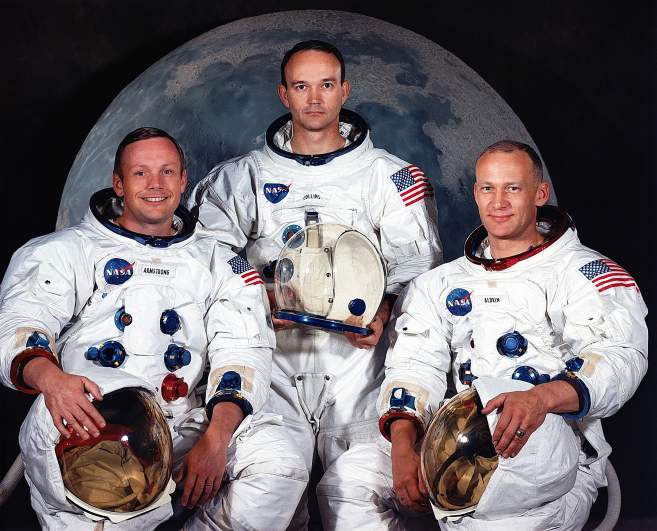
Getty The National Aeronautics and Space Administration (NASA) has named these three astronauts as the prime crew of the Apollo 11 lunar landing mission. Left to right, are Neil A. Armstrong, commander; Michael Collins, command module pilot; and Edwin E. Aldrin Jr., lunar module pilot.
Damien Chazelle, the director, explained the decision to Deadline, saying, “I wanted the primary focus in that scene to be on Neil’s solitary moments on the moon — his point of view as he first exited the LEM, his time spent at Little West Crater, the memories that may have crossed his mind during his lunar EVA….Although Neil didn’t see himself that way, he was an American hero. He was also an engineer and a pilot, a father and a friend, a man who suffered privately through great tragedies with incredible grace. This is why, though there are numerous shots of the American flag on the moon.” You can read his complete statement here.

Neil Armstrong steps into history July 20, 1969 by leaving the first human footprint on the surface of the moon.
Neil Armstrong’s two sons, who were heavily involved in the movie, also defended it. Mark and Rick Armstrong said in a statement, “Although Neil didn’t see himself that way, he was an American hero. He was also an engineer and a pilot, a father and a friend, a man who suffered privately through great tragedies with incredible grace. This is why, though there are numerous shots of the American flag on the moon, the filmmakers chose to focus on Neil looking back at the earth, his walk to Little West Crater, his unique, personal experience of completing this journey, a journey that has seen so many incredible highs and devastating lows.”
Trump Compared Armstrong Planting the Flag on the Moon to the NFL National Anthem Controversy
On October 12, 2018, President Trump appeared at a campaign rally in Lebanon, Ohio. That’s the community where Neil Armstrong spent much of his life after his NASA and moon walking days, working as a professor and living on a farm (Armstrong died in 2012 after complications from heart surgery). Trump equated the flag controversy to the NFL National Anthem kneeling debate.
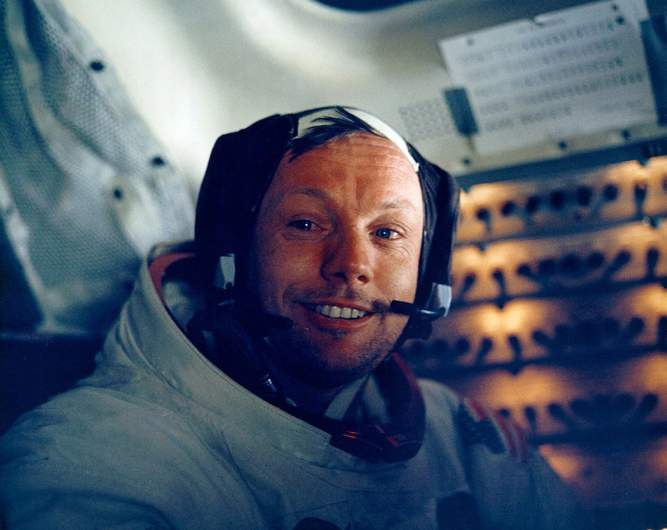
GettyAstronaut Neil Armstrong smiles inside the Lunar Module July 20, 1969.
“Ohio is the state that gave us the Wright brothers,” Trump said. “It gave us Neil Armstrong. He’s the man that planted the flag – think of that – on the face of the moon. There was no kneeling, there was no nothing, there was no games, boom.”
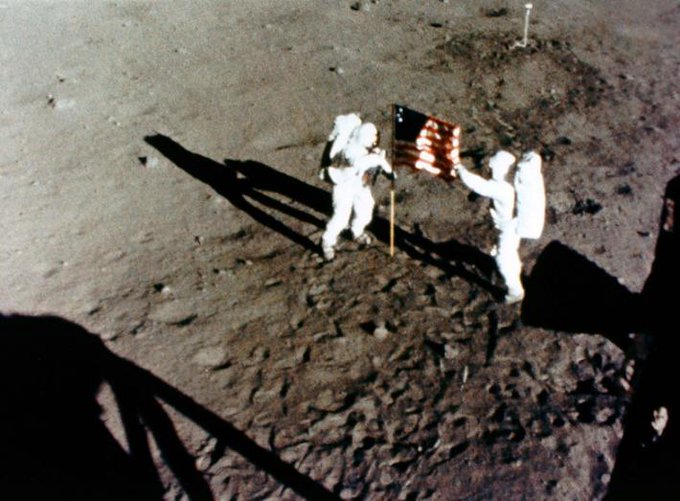

Comments
First Man & the Flag: Why Neil Armstrong Movie Omitted It